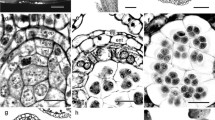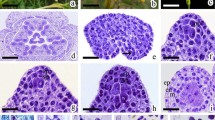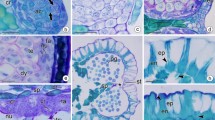Abstract
Biebersteinia, a perennial herb of five species distributed from Greece to Central Asia, was long considered to be placed in, or near Geraniaceae. Recent molecular analyses, however, have shown that the genus is the sole member of the family Biebersteiniaceae in Sapindales (not including Geraniaceae). Here, we report the embryological features of Biebersteinia and provide embryological corroboration for the molecular sapindalean affinities of the genus. We compared its embryology with those of eight other families of Sapindales, as well as with those of the related orders Huerteales, Malvales, and Brassicales. Overall comparisons showed that Biebersteinia fits in Sapindales because of the presence of anther tapetal cells with polyploid nuclear mass and non-fibrous exotegmen. Further, the genus is characterized by three-celled pollen grains, tetrasporic 16-nucleate Penaea-type female gametophyte, unitegmic ovules, pseudoporogamy, and the chalaza shifting its position near the concave side in the post-fertilization stage. A considerable number of autapomorphies, combined with the lack of synapomorphies with other sapindalean families, supports placing Biebersteinia in its own family. Biebersteiniaceae appear to represent an early divergent lineage of Sapindales. Previous descriptions of seed coats, which were considered to have developed from “bitegmic” ovules, were revised.







Similar content being viewed by others
References
APG (Angiosperm Phylogeny Group) (1998) An ordinal classification of the families of flowering plants. Ann Missouri Bot Gard 85:531–553
APGII (Angiosperm Phylogeny Group II) (2003) An update of the Angiosperm Phylogeny Group classification for the orders and families of flowering plants: APG II. Bot J Linn Soc 141:399–436
APGIII (Angiosperm Phylogeny Group III) (2009) An update of the Angiosperm Phylogeny Group classification for the orders and families of flowering plants: APG III. Bot J Linn Soc 161:105–121
Aryavand MA (1975) Contribution á l’cytotaxonomique de Biebersteinia multifida DC. (Géraniacées). C R Hebd Séances Acad Sci (Paris) D 280:1551–1554
Bacchi O (1943) Cytological observations in Citrus: III. Megasporogenesis, fertilization, and polyembryony. Bot Gaz 105:221–225
Bachelier JB, Endress PK (2007) Development of inflorescences, cupules and flowers in Amphipterygium and comparison with Pistacia (Anacardiaceae). Int J Plant Sci 168:1237–1253
Bachelier JB, Endress PK (2008) Floral structure of Kirkia (Kirkiaceae) and its position in Sapindales. Ann Bot (London) 102:539–550
Bachelier JB, Endress PK (2009) Comparative floral morphology and anatomy of Anacardiaceae and Burseraceae (Sapindales), with a special focus on gynoecium structure and evolution. Bot J Linn Soc 159:499–571
Bakker FT, Vassiliades DD, Morton C (1998) Phylogenetic relationships of Biebersteinia Stephan (Geraniaceae) inferred from rbcL and atpB sequence comparisons. Bot J Linn Soc 127:149–158
Banerji I (1954) Morphological and cytological studies on Citrus grandis Osbeck. Phytomorphology 4:390–396
Banerji I, Chaudhuri KL (1944) A contribution to the life-history of Litchi chinensis Sonn. Proc Indian Acad Sci B 19:19–27
Boesewinkel FD (1977) Development of ovule and testa in Rutaceae I: Ruta, Zanthoxylum, and Skimmia. Acta Bot Neerl 26:193–211
Boesewinkel FD (1978) Development of ovule and testa in Rutaceae III: some representatives of the Aurantioideae. Acta Bot Neerl 27:341–354
Boesewinkel FD (1981) Development of the seed of Trichilia grandiflora Oliv. (Meliaceae). Acta Bot Neerl 30:459–464
Boesewinkel FD (1984) Development of ovule and seed coat in Cneorum tricoccon L. (Cneoraceae). Acta Bot Neerl 33:61–70
Boesewinkel FD (1997) Seed structure and phylogenetic relationships of the Geraniales. Bot Jahrb Syst 119:277–291
Boesewinkel FD, Bouman F (1978) Development of ovule and testa in Rutaceae II: the unitegmic and pachychalazal seed of Glycosmis cf. arborea (Roxb.) D.C. Acta Bot Neerl 27:69–78
Boissier E (1867) Biebersteiniae. Flora Orientalis, vol 1. H. Georg, Basilee, pp 899–900
Brewbaker JL (1967) The distribution and phylogenetic significance of binucleate and trinucleate pollen grains in angiosperms. Am J Bot 54:1069–1083
Carmello-Guerreiro SM, Paoli AAS (2005) Anatomy of the pericarp and seed-coat of Lithraea molleoides (Vell.) Engl. (Anacardiaceae) with taxonomic notes. Braz Arch Biol Technol 48:599–610
Copeland HF (1955) The reproductive structures of Pistacia chinensis (Anacardiaceae). Phytomorphology 5:440–449
Copeland HF (1959) The reproductive structures of Schinus molle (Anacardiaceae). Madroño 15:14–25
Copeland HF (1961) Observations on the reproductive structures of Anacardium occidentale. Phytomorphology 11:315–325
Copeland HF, Doyel BE (1940) Some features of the structure of Toxicodendron diversiloba. Am J Bot 27:932–939
Corner EJH (1976) The seeds of dicotyledons, vol 1, 2. Cambridge University Press, Cambridge
Cronquist A (1981) An integrated system of classification of flowering plants. Columbia University Press, New York
Cronquist A (1988) The evolution and classification of flowering plants, 2nd edn. The New York Botanical Garden, New York
Dahlgren G (1989) The last Dahlgrenogram. System of classification of the dicotyledons. In: Tan K (ed) The Davis and Hedge festschrift. Edinburgh University Press, Edinburgh, pp 249–260
David E (1938) Embryologische Untersuchungen an Myoporaceen, Salvadoraceen, Sapindaceen und Hippocrateaceen. Planta 28:680–703
Desai S (1962) Cytology and embryology of the Rutaceae. Phytomorphology 12:178–184
Endlicher S (1841) Biebersteinieae. In: Enchiridion Botanicum. Lipsiae, Sumptibus G. Engelmann, Viennae, p. 618
Endress PK, Davis CC, Matthews ML (2013) Advances in the floral structural characterization of the major subclades of Malpighiales, one of the largest orders of flowering plants. Ann Bot 111:969–985
Garudamma GK (1956) Studies in the Meliaceae. I. Development of the embryo in Azadirachta indica A. Juss. J Indian Bot Soc 35:222–225
Garudamma GK (1957) Studies in the Meliaceae. II. Gametogenesis in Melia azadirachta Linn. J Indian Bot Soc 36:227–231
Ghosh RB (1966a) Studies in the family Meliaceae. I. Development of the female gametophyte of Aphanamixis polystachya (Wall) Parker = Amoora rohituka (W.A). Beitr Biol Pflanzen 42:133–138
Ghosh RB (1966b) Studies in the family Meliaceae. II. The development of the gametophytes in Walsura piscidia Roxb. Beitr Biol Pflanzen 42:373–380
Goldberg A (1986) Classification, evolution, and phylogeny of the families of dicotyledons. Smithsonian Institution Press, Washington
Grimm J (1912) Entwicklungsgeschichtliche Untersuchungen an Rhus und Coriaria. Flora 104:309–334
Groppo M, Pirani JR, Salatino MLF, Blanco SR, Kallunki JA (2008) Phylogeny of Rutaceae based on two noncoding regions from cpDNA. Am J Bot 95:985–1005
Grundwag M (1976) Embryology and fruit development in four species of Pistacia L. (Anacardiaceae). Bot J Linn Soc 73:355–370
Grundwag M, Fahn A (1969) The relation of embryology to the low seed set in Pistacia vera (Anacardiaceae). Phytomorphology 19:225–235
Guérin P (1901) Développement de la graine et en particulier du tégument séminal de quelques Sapindacées. J Bot (Paris) 15:336–362
Haskell DA, Postlethwait SN (1971) Structure and histogenesis of the embryo of Acer sachharinum 1. Embryo sac and proembryo. Am J Bot 58:595–603
Huber H (1993) Neurada—eine Gattung der Malvales. Sendtnera 1:7–10
Johri BM, Ahuja MR (1957) A contribution to the floral morphology and embryology of Aegle marmelos Correa. Phytomorphology 7:10–24
Kamelina OP (1994) Embryology and systematic position of Tetradiclis (Tetradiclidaceae). Bot Zhur 79:11–27 (in Russian with English summary)
Kamelina OP, Konnova VA (1990) Embryological characters of the genus Biebersteinia Stephan in relation to its systematic position. Doklady Acad Sci Tajik SSR 33:193–195 (in Russian)
Kapil RN, Ahluwalia K (1963) Embryology of Peganum harmala Linn. Phytomorphology 13:127–140
Kelkar SS (1958a) Embryology of Rhus mysorensis Heyne. J Indian Bot Soc 37:114–122
Kelkar SS (1958b) A contribution to the embryology of Lannea coromandelica (Houtt.) Merr. J Univ Bombay 26:152–159
Kelkar SS (1961) The development of endosperm and embryo in Lannea coromandelica (Houtt) Merr. J Univ Bombay 29:1–5
Khushalani I (1963) Floral morphology and embryology of Acer oblongum. Phyton (Austria) 10:275–284
Knuth R (1912) Geraniaceae. In: Engler A (ed) Das Pflanzenreich IV. 129, W. Engelmann, Leipzig, pp. 1–640
Li H, Fang W (2011) Development process of megaspore and microspore in desert cherry—Nitraria tangutorum. J Arid Land Res Environ 25:190–194 (in Chinese with English summary)
Li S, Tu L (1990a) The studies on the embryology of Nitraria sibirica Pall. 1. The development of microspore and male-gametophyte. Acta Scient Nat Univ Intramongoliae 21:112–118 (in Chinese with English summary)
Li S, Tu L (1990b) The studies on the embryology of Nitraria sibirica Pall. 2. The development of the megaspore and the female gametophyte. Acta Scient Nat Univ Intramongoliae 21:119–125 (in Chinese with English summary)
Li S, Tu L (1991a) The studies on the embryology of Nitraria sibirica Pall. 3. The developmental anatomy of the fruit and seed. Acta Scient Nat Univ Intramongoliae 22:389–432 (in Chinese with English summary)
Li S, Tu L (1991b) Studies on the development of the embryo and endosperm of Nitraria sibirica Pall. Acta Bot Sinica 33:500–506
List A, Steward FC (1965) The nucellus, embryo sac, endosperm, and embryo of Aesculus and their interdependence during growth. Ann Bot 29:1–15
Martínez-Pallé E, Herrero M (1995) The ponticulus: a structure bridging pollen tube access to the pollen tube in Pistacia vera. Sex Plant Repro 8:217–222
Mauritzon J (1935) Über die Embryologie der Familie Rutaceae. Svensk Bot Tidskr 29:319–347
Mauritzon J (1936) Zur Embryologie und systematischen Abgrenzung der Reihen Terebinthales und Celastrales. Bot Not 1936:161–212
Muellner AN (2011) Biebersteiniaceae. In: Kubitszki K (ed) The families and genera of vascular plants, vol 10. Springer, Heidelberg, pp 72–75
Muellner AN, Vassiliades DD, Renner SS (2007) Placing Bieberteiniaceae, a herbaceous clade of Sapindales, in a temporal and geographic context. Plant Syst Evol 266:233–252
Murbeck SV (1916) Über die Organisation, Biologie und Verwandtschaftlichen Beziehungen der Neuradaceen. Lunds Univ Arrskr 12:1–29
Nair NC (1958) Studies on Meliaceae 3. Floral morphology and embryology of Sandoricum indicum Cav. Phyton (Argentina) 10:145–151
Nair NC (1959a) Studies on Meliaceae 1. Floral morphology and embryology of Naregamia alata W. & A. J Indian Bot Soc 38:353–366
Nair NC (1959b) Studies on Meliaceae 2. Floral morphology and embryology of Melia azedarach Linn.: a reinvestigation. J Indian Bot Soc 38:367–378
Nair NC, Joseph TC (1957) Floral morphology and embryology of Samadera indica. Bot Gaz 119:104–115
Nair NC, Joseph TC (1960) Morphology and embryology of Cardiospermum halicacabum Linn. J Indian Bot Soc 39:176–194
Nair NC, Kanta K (1961) Studies in Meliaceae 4. Floral morphology and embryology of Azadirachta indica A. Juss.: a reinvestigation. J Indian Bot Soc 40:382–396
Nair NC, Sukumaran NP (1960) Floral morphology and embryology of Brucea amarissima. Bot Gaz 121:175–185
Narayana LL (1957) Embryology of two Simaroubaceae. Curr Sci 10:323–324
Narayana LL (1958) Floral anatomy and embryology of Cipadessa baccifera Miq. J Indian Bot Soc 37:147–154
Narayana LL (1959) Microsporogenesis and female gametophyte in Boswellia serrata Roxb. Curr Sci 28:77–78
Narayana LL (1960) Studies in Burseraceae-II. J Indian Bot Soc 39:402–409
Narayana LL (1963) A note on the embryology of a few Rutaceae. Curr Sci 32:516–517
Netolitzky F (1926) Anatomic der Angiospermen-Samen. In: Linsbauer K (ed) Handbuch der Pflanzenanatomie, vol X 4. Bornträger, Berlin
Pell SK (2004) Molecular systematics of the cashew family (Anacardiaceae). PhD. Thesis, Louisiana State University
Pfeiffer WM (1912) The morphology of Leitneria floridana. Bot Gaz 53:189–203
Prakash N, Lim AL, Manurung R (1977) Embryology of duku and langsat varieties of Lansium domesticum. Phytomorphology 27:50–58
Robbertse PJ, von Teichman I, van Rensburg HJ (1986) A re-evaluation of the structure of the mango ovule in comparison with those of a few other Anacardiaceae species. S Afr J Bot 52:17–24
Schmid R (1986) On cornerian and other terminology of angiospermous and gymnospermous seed coats: historical perspective and terminological recommendations. Taxon 35:476–491
Scholz H (1964) Geraniales. In: Melchior H (ed) A Engler’s Syllabus der Pflanzenfamilien. II. Gebrüder Borntraeger, Berlin, pp 246–262
Shen S, Huang R (1997) Cytological and morpho-anatomical studies of Biebersteinia heterostemon Maxim. Acta Biol Plateau Sinica 13:5–8 (in Chinese with English summary)
Shukla RD (1954) Gametophytes in Balsamodendron mukul Hook. Curr Sci 23:333
Shuraki YD, Sedgley M (1997) Pollen tube pathway and stimulation of embryo sac development in Pistacia vera (Anacardiaceae). Ann Bot 79:361–369
Sogo A, Tobe H (2006) The evolution of fertilization modes independent of the micropyle in Fagales and ‘pseudoporogamy’. Plant Syst Evol 259:73–80
Soltis DE, Soltis PS, Chase MW, Mort ME, Albach DC, Zanis M, Savolainen V, Hahn WH, Hoot SB, Fay MF, Axtell M, Swensen SM, Prince LM, Kress WJ, Nixon KC, Farris JS (2000) Angiosperm phylogeny inferred from 18S rDNA, rbcL, and atpB sequences. Bot J Linn Soc 133:381–461
Soltis DE, Smith SA, Cellinese N, Wurdack KJ, Tank DC, Brockington SF, Refulio-Rodriguez NF, Walker JB, Moore MJ, Carlsward BS, Bell CD, Latvis M, Crawley S, Black C, Diouf D, Xi Z, Rushworth CA, Gitzendanner MA, Sytsma KJ, Qiu YL, Hilu KW, Davis CC, Sanderson MJ, Beaman RS, Olmstead RG, Judd WS, Donoghue MJ, Soltis PS (2011) Angiosperm phylogeny: 17 genes, 640 taxa. Am J Bot 98:704–730
Srinivasachar D (1940) Morphological studies in the family Anacardiaceae. Half-Yearly J Mysore Univ, B-Sci 1:13–21
Srivastava GN (1968) Male and female gametophytes and development of the seed in Bursera delpechiana Poiss. J Indian Bot Soc 47:53–59
Stephan F (1811) Description de deux nouveaux genres de plantes. Mém Soc Imp Nat Mosc 2(1):89–90
Stephens EL (1909) The embryo-sac and embryo of certain Penaeaceae. Ann Bot 23:363–378
Stevens PF (2001 onwards) Angiosperm phylogeny Website. Version 12, July 2012. http://www.mobot.org/MOBOT/research/APweb/ (accessed March 4, 2014)
Takhtajan A (1986) Floristic regions of the world. University of California Press, Berkeley
The Plant List (2013) Version 1.1. Published on the Internet; http://www.theplantlist.org/ (accessed 1st January)
Thorne RT (1992) Classification and geography of the flowering plants. Bot Rev (Lancaster) 58:225–348
Tobe H (1989) The embryology of angiosperms: its broad application to the systematic and evolutionary study. Bot Mag (Tokyo) 102:351–367
Tobe H (2011) Embryological evidence supports the transfer of Leitneria floridana to the family Simaroubaceae. Ann Missouri Bot Gard 98:277–293
Tobe H, Kadokawa T (2010) Endosperm development in the Araceae (Alismatales) and evolution of developmental modes in monocots. J Plant Res 123:731–739
Tobe H, Peng C-I (1990) The embryology and taxonomic relationships of Bretschneidera (Bretschneideraceae). Bot J Linn Soc 103:139–152
Tobe H, Raven PH (1984a) The embryology and relationships of Penaeaceae (Myrtales). Plant Syst Evol 146:181–195
Tobe H, Raven PH (1984b) The number of cells in the pollen of Melastomataceae (Myrtales). Bot Mag (Tokyo) 97:131–136
Tobe H, Raven PH (1996) Embryology of Onagraceae (Myrtales): characteristics, variation and relationships. Telopea 8:667–688
Tobe H, Raven PH (2008) Embryology of Koeberlinia (Koeberliniaceae): evidence for core brassicalean affinities. Am J Bot 95:1475–1486
Tobe H, Raven PH (2011) Embryology of the Irvingiaceae, a family with uncertain relationships among the Malpighiales. J Plant Res 124:577–591
Van der Pijl (1957) On the arilloids of Nephelium, Euphoria, Litchi and Aesculus, and the seeds of Sapindaceae in general. Acta Bot Neerl 6:618–641
Von Teichman I (1988) Note on the ontogeny and structure of the seed-coat of Sclerocarya birrea (Richard) Hochst. sbsp. caffra Kokwaro (Anacardiaceae). Bot J Linn Soc 98:153–158
Von Teichman I (1991) Ontogeny of the seed-coat of Rhus lancea L. fil., and pachychalazy in the Anacardiaceae. Bot J Linn Soc 107:35–47
Von Teichman I, van Wyk AE (1988) The ontogeny and structure of the pericarp and seed of Harpephyllum caffrum Bernh. ex Krauiss (Anacardiaceae). Bot J Linn Soc 98:159–176
Wang H, Moore MJ, Soltis PS, Bell CD, Brockington SF, Alexandre R, Davis CC, Latvis M, Manchester SR, Soltis DE (2009) Rosid radiation and the rapid rise of angiosperm-dominated forests. Proc Natl Acad Sci USA 106:3853–3858
Weckerle CS, Rutishauser R (2003) Comparative morphology and systematic position of Averrhoidium within Sapindaceae. Int J Plant Sci 164:775–792
Weckerle CS, Rutishauser R (2005) Gynoecium, fruit and seed structure of Paullinieae (Sapindaceae). Bot J Linn Soc 147:159–189
Weeks A, Daly DC, Simpson BB (2005) The phylogenetic history and biogeography of the frankincense and myrrh family (Burseraceae) based on nuclear and chloroplast sequence data. Mol Phyl Evol 35:85–101
Wiger J (1935) Embryological studies in the families Buxaceae, Meliaceae, Simaroubaceae and Burseraceae. Diss. Lund
Worberg A, Alford MH, Quandt D, Borsch T (2009) Huerteales sister to Brassicales plus Malvales, and newly circumscribed to include Dipentodon, Gerrardina, Huertea, Perrottetia, and Tapiscia. Taxon 58:468–478
Zhou QY, Liu GS (2012) The embryology of Xanthoceras and its phylogenetic implications. Plant Syst Evol 298:457–468
Author information
Authors and Affiliations
Corresponding author
Electronic supplementary material
Below is the link to the electronic supplementary material.
Appendix 1. Selected sources of data on embryological features for individual families of Sapindales
Appendix 1. Selected sources of data on embryological features for individual families of Sapindales
Anacardiaceae: Bachelier and Endress (2007, 2009), Carmello-Guerreiro and Paoli (2005), Copeland (1955, 1959, 1961), Copeland and Doyel (1940), Corner (1976), Grimm (1912), Grundwag (1976), Grundwag and Fahn (1969) Kelkar (1958a, b, 1961), Martínez-Pallé and Herrero (1995), Robbertse et al. (1986), Shuraki and Sedgley (1997), Srinivasachar (1940), von Teichman (1988, 1991), von Teichman and van Wyk (1988); Biebersteiniaeae: Boesewinkel (1997), Corner (1976), Kamelina and Konnova (1990); Burseraceae: Bachelier and Endress (2009), Corner (1976), Wiger (1935); Kirkiacee: Bachelier and Endress (2008); Meliaceae: Boesewinkel (1981), Corner (1976), Garudamma (1956, 1957), Ghosh (1966a, b), Nair (1958, 1959a, b), Nair and Kanta (1961), Narayana (1958), Prakash et al. (1977), Wiger (1935); Nitrariaceae: Kamelina (1994), Kapil and Ahluwalia (1963), Li and Fang (2011), Li and Tu (1990a, b, 1991a, b); Rutaceae: Bacchi (1943), Banerji (1954), Boesewinkel (1977, 1978; 1984), Boesewinkel and Bouman (1978), Corner (1976), Desai (1962), Johri and Ahuja (1957), Mauritzon (1935, 1936), Narayana (1963); Sapindaceae: Banerji and Chaudhuri (1944), Corner (1976), David (1938), Guérin (1901), Haskell and Postlethwait (1971), Khushalani (1963), List and Steward (1965), Mauritzon (1936), Nair and Joseph (1960), Netolitzky (1926), van der Pijl (1957), Tobe and Peng (1990), Weckerle and Rutishauser (2003, 2005), Zhou and Liu (2012); Simaroubaceae: Corner (1976), Nair and Joseph (1957), Nair and Sukumaran (1960), Narayana (1957), Pfeiffer (1912), Tobe (2011), Wiger (1935).
We are grateful to Peter H. Raven, Yang Zhong, Hongya Gu, Yang Zhong, Li-Jia Qu, David Boufford, Ihsan Al-Shehbaz, Christopher Davidson, and Kaka Saman for their assistance in getting materials and information used for the present study. The study was supported by a Grant-in-Aid for Scientific Research from the Japan Society for the Promotion of Science (No. 25440208).
Rights and permissions
About this article
Cite this article
Yamamoto, T., Vassiliades, D.D. & Tobe, H. Embryology of Biebersteinia (Biebersteiniaceae, Sapindales): characteristics and comparisons with related families. J Plant Res 127, 599–615 (2014). https://doi.org/10.1007/s10265-014-0645-z
Received:
Accepted:
Published:
Issue Date:
DOI: https://doi.org/10.1007/s10265-014-0645-z




